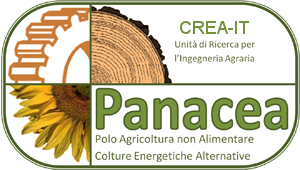Bioenergy will make a relevant contribution to achieve the European target expected in the climate and energy package by 2020. European strategy on bio-economy will encourage the use of agriculture by-products, above all because not involved in the diatribe of food versus energy. Among the agricultural by-products suitable for energy production, pruning are considered an interesting and valuable resource, still not adequately exploited. Several studies focused on the assessment of pruning availability and its energy potential have been carried out at different spatial levels (European, national, regional, local), in different years, and with different methodologies.
The European Southern countries have an enormous potential in terms of pruning biomass production. In fact, in this area the cultivation of the majority of permanent crops is concentrated (see table below). As can be seen, grapes and olives are the main species. The olive tree is more widespread in Spain (2.5 106 ha), in Italy (1.1 106 ha) and in Greece (850 103 ha). The vineyard is widely cultivated in Spain (963 103 ha), in France (764 103 ha) and in Italy (725 103 ha). Large areas are interested in the cultivation of citrus in Spain (313 103 ha) and in Italy (168 103 ha). Furthermore, Italy and Spain record the main cultivations of peaches (both more than 80 103 ha), and of the other orchards (respectively 160 103 ha and 120 103 ha). As for the fruit with shell, the figure for the cultivation of the almond trees in Spain (536 x 103 ha) and hazelnut in Italy (70 103 ha) stands out.
|
Italy |
Spain |
Portugal |
Greece |
France |
|
|
Apple |
56.9 |
31.5 |
12.5 |
13.5 |
41.9 |
|
Pear |
39.4 |
27.0 |
11.0 |
4.8 |
6.0 |
|
Peach |
85.6 |
81.4 |
3.7 |
42.2 |
12.9 |
|
Apricot |
19.6 |
18.7 |
0.4 |
6.0 |
13.9 |
|
Cherry |
30.2 |
25.0 |
5.7 |
9.8 |
9.6 |
|
Plum |
14.2 |
17.1 |
1.6 |
1.4 |
18.3 |
|
Almond |
75.5 |
536.3 |
26.9 |
14.1 |
1.3 |
|
Hazelnut |
70.5 |
14.1 |
0.4 |
0.4 |
4.1 |
|
Citrus |
168.2 |
313.0 |
19.5 |
50.0 |
2.0 |
|
Vineyard |
725.4 |
963.1 |
179.5 |
103.2 |
764.1 |
|
Olive |
1,144.4 |
2,503.7 |
343.2 |
850.0 |
16.9 |
The assessment of the potential production of the residues is a crucial point and a pre-requisite for the planning and the organization of the agro-energy chain. Such evaluation requires both on-field analysis of pruning yield, but also the use of appropriate indices to represent and compare the productivity. Analyzing the main works reporting surveys on pruning production at national level, it emerges as yields pruning is expressed using three main parameters: pruning per hectare, pruning per plant, pruning to the main product ratio ( see box below). The availability of the values on the main product yields and the number of plants per hectare allows the switching between indices and thus the comparability of data and information.

The identification of a set of useful and shared indices could help in assessing the right pruning potential in order to obtain an updated and representative biomass estimation, referred to a specific year and with a geographical detail. Thus, for several variables (e.g. permanent crop, climatic zones, pedologic characteristics, type of product, etc.) a tiered approach could be particularly informative.
The knowledge of the pruning biomass potential, allowing a careful forecast of the pruning availability during time (as shown for the Italian context in Figure below), will optimize the scheduling of logistic (harvesting, collecting, transport and storage) and, hence, the profitability of the whole chain.




